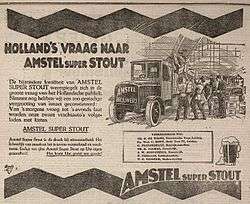Amstel Brewery
|
| |
| Industry | Alcoholic beverage |
|---|---|
| Founded | 1870 |
| Headquarters | Zoeterwoude, Netherlands |
| Products | Beer |
Production output | 36 million litres |
| Owner | Heineken International |
| Website | http://www.amstel.com/ |

Amstel Brewery (Amstelbrouwerij, Dutch pronunciation: [ˈɑmstəlbrʌwəˌrɛi̯]) is a Dutch brewery founded in 1870 on the Mauritskade in Amsterdam, Netherlands. It was taken over by Heineken International in 1968, and the brewing plant closed down in 1982, with production moving to the main Heineken plant at Zoeterwoude.
History
The brewery was founded on 11 June 1870 in Amsterdam and named after the Amstel River, the waters of which also served for refrigeration. By 1872, Amstel was annually producing 10,000 hectoliters. For the purpose of storing the beer, winter ice from canals was kept in special double-walled cellars. Originally, the beer was mostly drunk in Amsterdam. From 1883, it was also exported to Great Britain and the Dutch East Indies.
The Beiersche Bierbrouwerij de Amstel (Amstel Bavarian beer brewery) was created in 1892 as a joint stock company. In 1915 the production of Amstel had increased twenty-fold and in 1926, Amstel consisted of a third of the Dutch beer exports. In 1941, Amstel, together with Heineken, bought up the Amsterdam brewery Van Vollenhoven's Bierbrouwerij, which was closed in 1961.
In 1954, Amstel built a brewery in Dutch Guiana. A few years later, Amstel was the first Dutch brewery to export beer in cans. At this time, the total exports of Amstel beer amounted to 101,000 hectoliters. In 1958 a subsidiary of Amstel produced its first beer in Jordan. In 1960, the third subsidiary of Amstel was opened in Curaçao. 1963 saw the opening of two new breweries, one in Puerto Rico and one in Greece.
Amstel was bought out by Heineken International in 1968.[1] In 1972 the Amstel Brewery in Amsterdam was closed and production was relocated to the main Heineken plant in Zoeterwoude. The building on the Mauritskade was torn down. Only the former administration building was kept and has since become part of the Hogeschool van Amsterdam.
At the end of the 20th century, in Spain, Heineken International decided to replace the local centennial brand El Águila and convert it into Amstel.
Beers
Heineken offers several beers under the Amstel brand.[2] Amstel Lager uses predominantly light pilsner malt, although some dark malt is also used. It is sold in 75 countries. Amstel Light is a 3.5% abv pale lager. Amstel 1870 is a slightly dark 5% abv lager. In France a beer called Amstel Free, with minimal alcohol content – about one per cent ABV – is produced. A non-alcoholic version can also be purchased in the Netherlands, Greece and other countries.
Amstel also markets a shandy called Amstel Radler in several countries. It contains 2% alcohol and it is a mix of lager beer and lemonade.
References
- ↑ Oliver, Garrett (2011). The Oxford Companion to Beer. Oxford University Press. p. 49. ISBN 9780195367133.
- ↑ Heineken Nederland